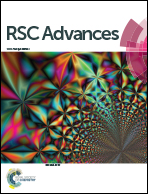Effects of supplemental organic carbon on long-term reduction and reoxidation of uranium†
Abstract
Bioreduction of mobile uranyl(VI) (UO22+) to sparingly soluble uraninite (U(IV)O2(s)) is a strategy that has been proposed for in situ remediation of uranium contaminated aquifers. That strategy faces the challenge of reoxidation of uraninite, with consequent release of soluble uranyl when the stimulation of U(VI) bioreduction is terminated. We tested the effects of supplemental organic carbon (ethanol) addition on the long-term reduction and subsequent reoxidation of uranium. In 620 days (31 pore volumes) flow-through bioreduction experiments with 1 or 10 mM ethanol, no obvious difference was observed in effluent U(VI), effluent nitrate, and effluent sulfate. However, a higher concentration of ethanol (10 mM) supported more extensive sulfate reduction to sulfide compared to lower ethanol (1 mM). Upon completion of bioreduction experiments, U(IV) in both 1 and 10 mM ethanol-fed columns was resistant to reoxidation upon addition of oxygenated water to the columns for 110 days (182 pore volumes). Columns that received a higher concentration of ethanol (10 mM) exhibited less U(IV) reoxidation in the presence of nitrate compared to 1 mM ethanol-fed column sediments, and similar results were observed in batch reoxidation experiments in which O2 was used as an oxidant. Our results demonstrate that supplemental organic carbon could protect biogenic U(IV) from remobilization upon intrusion of oxidants.


 Please wait while we load your content...
Please wait while we load your content...